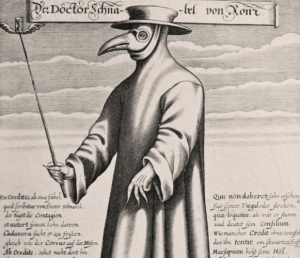Mask Theater Past And Present: The Medieval Antecedents Of Our Bizarre 21st Century Ritual.
You’re probably familiar with the “plague doctor” mask, most often associated with the infamous Black Death of the fourteenth century, and the later outbreaks of bubonic plague that recurred in Europe for centuries afterward. The mask, which included spectacles and a long, hollow beak, was certainly distinctive, but its unusual look was more than just aesthetic. The beak would be filled with herbs and spices that would produce pleasant smells, which were believed to protect the doctor from invisible “poisonous emanations” in the air, called “miasma,” which created harmful imbalances in a person’s “humors,” or bodily fluids. The presence of this poisonous air was signified by foul smells, often arising from rotting carcasses or vegetables, and the mask’s beak shape was meant to “give the air sufficient time to be suffused by the protective herbs before it hit the plague doctor’s nostrils and lungs.”
It would be easy, given our modern conceit in appraising the inhabitants of the past as ignorant bumpkins, to mock these practices as peculiar and ridiculous, knowing as we do how useless they were. But the plague doctors could be forgiven for all this ritualistic pageantry, and the false sense of security it provided, if only because they lived long before modern germ theory was even a thought.
The symbolic and useless mask-pageantry in which we Americans are now engaging, on the other hand, is less forgivable.
Here’s an example. Upon entering a nearly-empty bar in Texas last month (just before the hopefully-primaried-in-2022 Greg Abbott shut them all down again), I was told by the masked bartender to go back outside, and to re-enter the establishment while wearing a mask. So, I walked outside, put on the ol’ train robber bandana that was buried in my pocket, and entered again. I then walked roughly fifteen feet to the bar, ordered a beer, and was told that I didn’t have to wear the mask anymore. However, if I decided to walk into the single-toilet restroom, I would have to put it back on, she said. Because coronaviruses like to hide and pounce not just at the doorway, but in the bathroom, I guess, and my silly bandana is somehow supposed to protect me from that.
Here’s another example that you’ve undoubtedly seen or experienced.
At your local grocery store, you are standing in a line that is several customers long. Everyone’s wearing masks, but still standing several feet apart. When you finally get to the cashier, you observe that the mask she’s wearing couldn’t be looser, with large gaps between the cloth and her face that you could drive a Buick through. But, in the unlikely event she’s infected, somehow the mask might still prevent coronavirus-carrying, microscopic droplets of moisture from escaping her mouth to infect anyone else, we all suppose. There’s a clear acrylic barrier annoyingly placed between you and the cashier for some reason, so you move a foot or so to the right so you can comfortably communicate with her around it. It’s time to pay, so you look down at the card reader, and there’s a thin layer of translucent plastic covering it (which looks suspiciously like the plastic food wrap from aisle 13), though you notice it hasn’t been changed by anyone since the six customers before you used it, and you assume hasn’t been changed for hours before that. But you confidently insert your card and press the keys with your bare fingers, anyway, knowing that the barrier provided serves as some sort of protection from the invisible coronavirus that is potentially lurking on every surface that you touch.
You don’t have to be a scientist to recognize that what I’ve described above are nothing more than useless symbolic rituals, and it’s all practically ineffective at stopping coronavirus spread, just as a plague mask was practically ineffective is stopping the spread of plague. But, unlike the plague doctors of the past, we should certainly know better than to go through any of these silly motions believing otherwise.
Just three months ago, hysteria about COVID-19 was in full swing, but the calls for mandatory masking weren’t prominent yet. Back in March and April, Dr. Fauci, the CDC, the Surgeon General, and the WHO all prescribed no guidance for healthy members of the public to wear masks, and, in fact, they all explicitly advised against the practice.
It isn’t hard to understand why. There was, and there remains, very little science suggesting that wearing a cloth mask like my stupid bandana does anything to reduce viral transmission.
At the Center for Infectious Disease Research and Policy (CIDRAP), Dr. Lisa Brousseu and Dr. Margaret Sietsema published commentary back in April arguing against recommendations for mandatory masking, stating unequivocally:
We do not recommend requiring the general public who do not have symptoms of COVID-19-like illness to routinely wear cloth or surgical masks because:
There is no scientific evidence they are effective in reducing the risk of SARS-COV-2 transmission. [emphasis added]
As you might expect, there have since been calls to remove this commentary from the website by the pro-mask crowd. The central reasons for the demand are that, sure, there’s not a lot of evidence that cloth masks work to curb the spread of COVID-19, but there’s also not a lot of evidence that the masks don’t work, either, given the limited data. Also, demanding that everyone wear masks that is better than doing nothing at all, the pro-mask advocates argue.
Neither of these are strong arguments, to say the least, and on July 16, the website updated the article to provide an explanation for keeping it available to the public, reiterating that there’s a dearth of evidence suggesting that cloth masks are effective.
But the original article posits an interesting, more general question that’s worth considering. Masks may “give people a false sense of security,” the article says. “If masks had been the solution in Asia, shouldn’t they have stopped the pandemic before it spread elsewhere?”
Indeed, a good question to ask. Let’s apply that logic more directly to California.
In my California county, we never had a mask requirement before Governor Newsom issued one statewide, and, like so many of my friends and neighbors, I never once wore a mask until mid-June. And yet, my county accounts for just 188 cases per 100,000 residents, less than 0.1 percent of the state’s cases, and precisely zero COVID deaths. Inversely, Los Angeles was one of the first cities to issue a large-scale and rigid masking mandate, very early in the pandemic. Los Angeles County alone now accounts for over 40 percent of the state’s cases, over 1,400 cases per 100,000 residents, and nearly four thousand deaths attributed to COVID-19.
You might be inclined to conclude that population density is a key factor in that difference, not the masks. Yet San Francisco County has, by far, the state’s densest population, and only represents 1.3 percent of the state’s cases, 533 cases per 100,000 residents, and just 50 deaths.
Granted, San Francisco also mandated masks in public, so, clearly, we must understand that there are myriad factors that contribute to these results. But it seems obvious that a mask mandate isn’t meaningful among them. Quite simply, if mask mandates are effective, why are the places that have enacted them often experiencing some of the worst results, while those places with no mask mandates have fared far better?
For the angry and loud mask advocates, such inconvenient evidence is inadmissible to the discussion, and the calls for mask mandates (even in red states like Texas) have become more aggressive, even as we continually learn that the virus isn’t nearly as deadly as it was once believed. Fatality rates are now convincingly evidenced to be 0.26 percent or lower, and with deaths clustered very specifically among the elderly and the significantly unhealthy. Targeted mitigation to protect at-risk Americans is achievable, while also allowing most Americans to go about their lives, but we are instead committing to more ridiculous efforts at holistic mitigation.
I do have a simple alternative to these silly and symbolic mask rituals that are becoming commonplace. We should just do what civilized people have done for many years before this pandemic, and what nearly every credible doctor advised until just a few months ago. Stay home if you’re sick, wash your hands regularly, and if you feel the urge to cough or sneeze, be courteous to others while doing it, and maybe cough or sneeze into a handkerchief that you keep in your pocket. Practically, it’s not much different than taking that handkerchief out of your pocket to wear on your face from time to time, and it’ll be much less ridiculous than what we’re all doing right now.
Willam Sullivan via American Thinker





